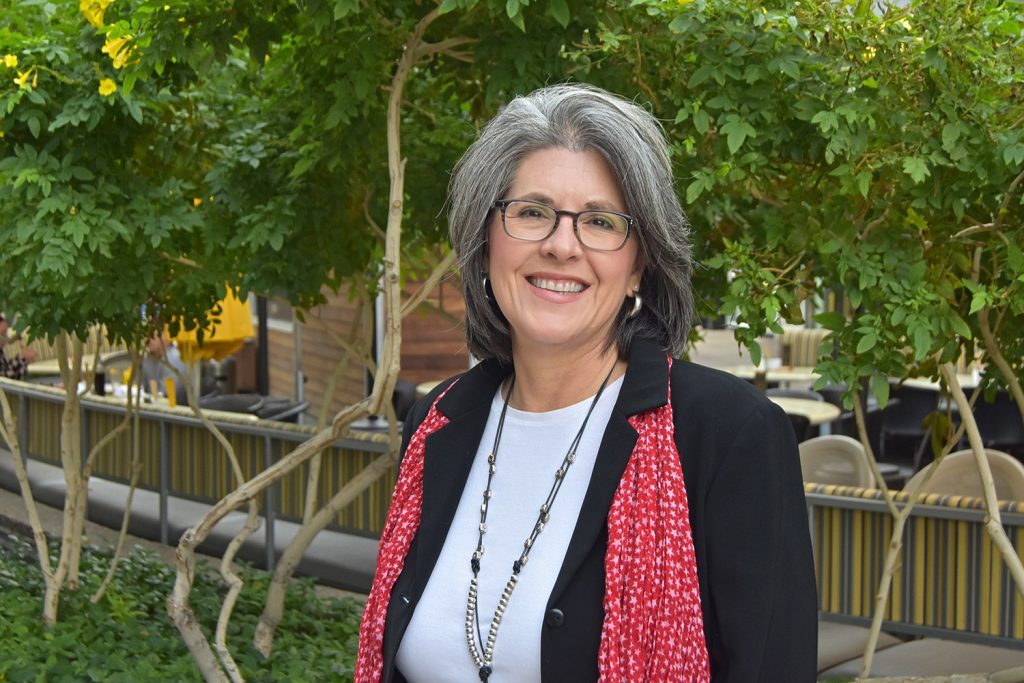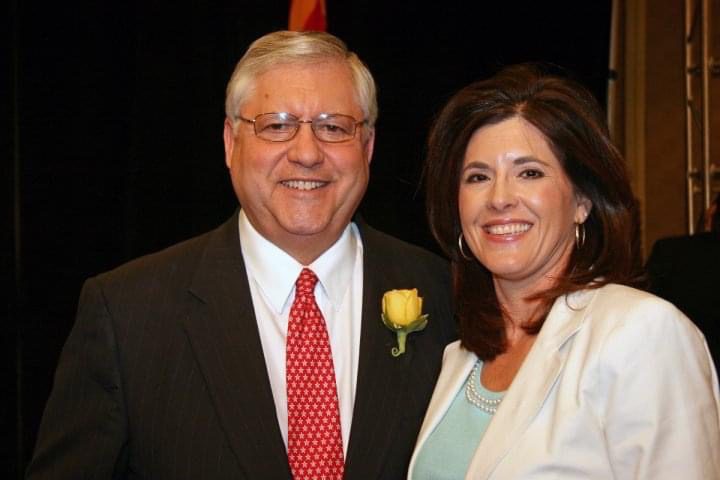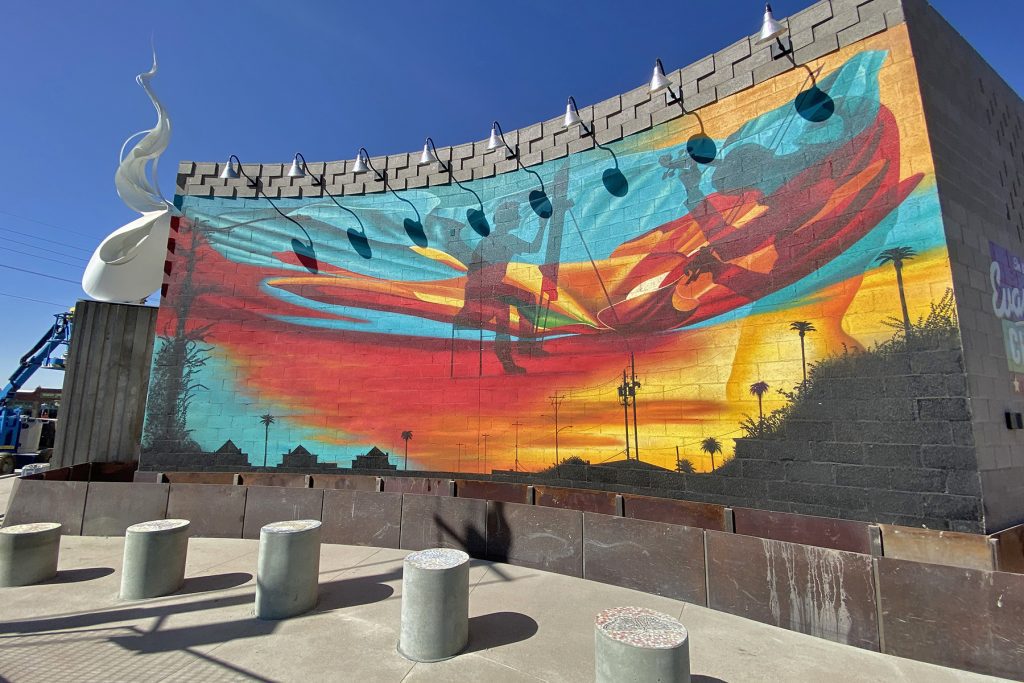Phoenix Community Alliance congratulates Kendra Lee to more than 36 years of service to both APS and her Downtown community!
The “City-Shapers” series fills in the gaps of historical knowledge of Phoenix Community Alliance, a four-decade old business advocacy organization that has influenced the growth of downtown and beyond.
In addition to decades of leadership, numerous board members have provided connectivity to Membership and to the city itself.
Former Board Chair Marty Shultz recruited Kendra Lee, from APS, into PCA in the early 2000’s, first as a Member, eventually rising to APS’ representative on the Board of Directors. Much of Lee’s service to the community as APS area manager can be seen in numerous Downtown projects.
From Member to board director, the community development meetings of PCA proved invaluable to Kendra to grasp a “strong understanding” how APS could address the challenges of a rapidly growing, vibrant Downtown.

Former PCA Board of Director Kendra Lee pictured outside the Downtown Phoenix, Inc./Phoenix Community Alliance offices. (Photo by Taylor Costello)
Q: Where did you come from? Are you a local?
Lee: I was born and raised on a cattle ranch in Montana. And then landed in the Camp Verde area. I started working at APS on June 2nd, 1986, and I worked in our customer business office in the Verde district and then in Flagstaff. I moved into our corporate headquarters at the Arizona Center offices in 1989. So from Camp Verde High School to the 18th floor Downtown.
Since January 1, 2000, I’ve been in an area manager role. Largely what I do is on the electrical and operation side of the business, but I work in APS’s Public Affairs department.
Q: Did you have connections to Downtown prior to you relocating to here?
Lee: My grandfather worked as a salesman at Hanny’s. I have some really cool photos of him as a model and salesman. And my grandmother worked at Goldwater’s and Diamonds at Park Central.
My mother also sang from the balcony at Hanny’s for a Christmas event. I have none of those skills!
Q: How did you become affiliated with PCA? When did you eventually join the board?
Lee: I would say that would have been early 2000s, largely because it could be everything from working on streetlight-related issues with the Downtown Phoenix Partnership [DPP] or Downtown developments, working with the Phoenix Convention Center, even then working with my late friend Don Keuth there.
But Marty Shultz recruited me to the Phoenix Community Alliance board. He was probably board chair at that time. When Marty went off the board, I became the official APS representative.
Q: What was the structure of PCA’s organization like then?
Lee: As far as the committees go, they weren’t formalized and more ad hoc based on things happening, like transportation, development, and connecting the state capitol with Downtown. It could be about light rail, what was going to happen with the convention center or things like that.
The Human Services Campus was a big part of the discussion, David Smith at the county, [PCA President] Don Keuth and Marty were huge advocates about what could we potentially build to support our unsheltered population and create a structure that would make something supportive to the community, but also what they refer to as a continuum of care.
What I liked about Don was his background as a civil engineer. We could talk the same language and we were really focused on the infrastructure.

Former PCA Chair Marty Shultz and Kendra Lee at an official function. (Photo Courtesy of Kendra Lee)
Q: What were some of downtown’s development and utility challenges?
Lee: I would describe it almost like the development of my knees; when I was five foot six in the fifth grade, I grew very fast and my knees couldn’t catch up.
Similarly, when Phoenix decided to grow, we grew too fast and our infrastructure wasn’t there to support it. Behind the scenes, we helped to make it look like magic, but that’s not always the case.
You think infrastructure is going to be available and it’s not. You can’t just put electricity or water pipes in the ground and have it waiting, that’s a lot of capital and money involved.
When we first realized we needed to build a new substation downtown and recognized all the electrical infrastructure needed for the buildout of the bioscience campus, which was one of the reasons for the original Evans Churchill substation [off Sixth and Garfield Street] in October 2008, the proximity [of the land identified for the new substation] was perfect.
When we’re building a substation, we usually look at a two-acre parcel. We didn’t have that. We had a tiny little footprint. We needed to stack equipment on the inside. So that’s what made for the taller walls because substation walls are typically about ten foot block.
The original design was these gray block walls, and that was not going to happen with the plans for Downtown. And then a civil designer inside APS went around and took a bunch of pictures of Downtown. We came back to the drawing board with something that was a kind of facade that resembled Artisan Village.
And it was kind of the first in the industry and still something that they point to.
Q: What was the difference between the first substation built by APS in 2008 and the one that recently finished in spring 2022?
Lee: We started looking for another location in the 2016-17 period. As things evolved over time, we didn’t want it to be a facade anymore. We wanted it to be active and pedestrian friendly. And it needed to have some sort of a park type atmosphere.
The interesting thing [with the first substation] I remember conversations with [City of Phoenix Assistant City Manager] Sheryl Sculley, [Downtown Phoenix Partnership President and CEO] Brian Kearney and Don Keuth where they wanted us to buy that [adjacent] property then.
Prior to the construction of the original substation in 2007, a Shell gas station already stood on the footprint of the adjoining lot, where the new substation now sits. Follow the link to learn more about the history of APS’ activated “Welcome to Roosevelt Row” substation/art installation.
They wanted us to put in a coffee shop. The concept would be an active storefront. The wall on the north side of that original substation was one blank block façade. It was always designed so a mural could eventually go there. The thought was that gas station would go away and you’d have that block wall as the fabric for a mural. But the car wash was always blocking it.
Here we are, and it does end up becoming a mural, 12 of them to be exact. I still tell everybody that particular design goes at that location. It’s designed to be “Welcome to Roosevelt Row,’ when you drive into Downtown.

On the southeast corner of Roosevelt Street & 7th Street, a mural by Tato Caraveo, before the installation of a ceramic and steel ‘Welcome to Roosevelt Row’ sign by Jeremy Arviso was installed in May 2022. (Photo by Taylor Costello)
Q: What do you hope your legacy with APS will be?
Lee: These substations are definitely part of my legacy. When we eventually rebuild our existing substation at Garfield and Second Street [originally built in the early ‘60s], we will build offices and art gallery space along the frontage and give that space back to Roosevelt Row. Every couple of weeks we’re having neighborhood meetings to build an idea of what they want the substation to look like.
Carla Wade, who owns Carly’s, who has had that view of the substation and infrastructure across the street for as long as she’s owned that restaurant was like, “I’m excited for this now.”
That’s what I’m always thrilled by. I want people to be proud of it. I feel like that’s what we’ve achieved with Evans Churchill [substation], because they look at that now and go, “How did a utility company do that?”
Since beginning as the Area Manager for 2000 in APS, Lee worked on countless transformative Downtown development projects, from the Phoenix Convention Center, ASU Downtown Phoenix Campus, Light Rail, CityScape, to even the Cordia district cooling system, tasked with providing chilled water to buildings.
Now, as Lee retires from an organization she worked for more than 36 years, she’s leaving a different Downtown literally equipped for bigger and better things than what she discovered as a transplant from Camp Verde.




